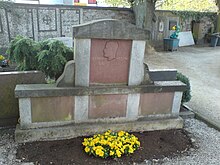Heinrich Jacobi (archaeologist)

Heinrich Christian Jacobi (born July 2, 1866 in Homburg before the height ; † March 3, 1946 ibid) was a German architect and Roman provincial archaeologist .
Life
Heinrich Christian Jacobi was born as the son of the Roman provincial archaeologist Louis Jacobi and his wife Henriette. Will was born in Homburg vor der Höhe. From 1886 to 1891 he studied architecture at the Technical University of Charlottenburg . During his student days he joined the later fraternity of Landsmannschaft Normannia . From 1895 to 1896 he directed the excavations in Adamklissi ( Romania ) on behalf of Grigore Tocilescu and traveled to North Africa for Roman excavations . He later worked as a government building supervisor ( trainee lawyer ) in Marburgactive, where he was appointed government architect ( assessor ) in 1896 . In 1899 he worked on behalf of the Prussian government at the Saalburg in Homburg before the height. There he was appointed royal building officer and state building inspector in 1911 and in 1912 - as his father's successor - director of the Saalburg Museum.
His first marriage was to Henriette Louise. The marriage remained childless but they adopted a girl, Hildegard called Hilde. After the death of his first wife in 1925, he married Henriette Louise Johanna Trapp, the granddaughter of Eduard Christian Trapp , in 1926 .
During the First World War , he accepted from the autumn of 1914 as a captain of the Landwehr in the replacement battalion of Fusilier Regiment No. 80 in Wiesbaden . In early 1915 he was appointed battalion leader in Reserve Infantry Regiment No. 83 in Homburg. After the war he worked again as director of the Saalburg Museum in Bad Homburg vor der Höhe. Around 1926 he received an honorary doctorate (as Dr.-Ing. E. H.). After reaching the age limit, he initially remained in office until 1936 and took over the management of the museum again from 1945 to 1946 after the end of the Second World War .
Castle Saalburg / Kirdorf
Together with his father Louis Jacobi , he was instrumental in the reconstruction of the Saalburg fort .
The evangelical memorial church he planned on Weberstrasse in Bad Homburg-Kirdorf was inaugurated on August 18, 1913.
Awards
- Red Eagle Order IV class
- Iron Cross II class in 1915
- Hessian bravery medal in 1916
- Officer's Cross of the Franz Josef Order with the war decoration, personally presented by Emperor Karl (1917)
- Officer's Cross of the Order of St. Alexander with Swords in 1917
- Bulgarian Silver Medal for Art & Science on Ribbon in 1918
- Cross of Merit for War Aid in 1918
Fonts
- The earth fort of the Saalburg. Reprint from the Saalburg yearbook. Report of the Saalburg Museum VI. 1914/1924. Frankfurt 1924.
- Guide through the Roman fort Saalburg and Homburg vor der Höhe. Schudt, Homburg 1905. 7th edition 1913.
- Small guide through the Saalburg and its collections. Taunusbote, Bad Homburg 1918.
- Guide through the Saalburg and its collections. Taunusbote, Bad Homburg 1921. 27th edition 1927.
- The Saalburg: guide through the fort and its collections. Taunusbote, Bad Homburg 1929. 13th edition 1936.
- The Homburg Railway and its predecessors. Reprint of the Taunusboten, Bad Homburg 1938.
literature
- Helge Dvorak: Biographical Lexicon of the German Burschenschaft. Volume II: Artists. Winter, Heidelberg 2018, ISBN 978-3-8253-6813-5 , p. 358.
- Dieter Planck , Andreas Thiel (ed.): The Limes Lexicon. Rome's borders from A to Z. Beck, Munich 2009, ISBN 978-3-406-568169 , p. 64.
Individual evidence
- ^ Paul Goldschmidt: On the history of the Landsmannschaft Normannia in Berlin 1842-1902. Berlin 1902.
- ^ Egon Schallmayer: One hundred years of Saalburg. Zabern, Mainz 1997, ISBN 3-80532350-6 , p. 32.
- ↑ Simone Dittmar: A man who always stood in the shadow of his father; in: Taunus-Zeitung of April 19, 2016, p. 10
- ^ War report I of the Landsmannschaft Normannia Berlin. Berlin 1914
- ↑ a b c War report II of the Landsmannschaft Normannia Berlin. Berlin, April 1915
- ↑ Kirdorf story
- ^ War report V of the Landsmannschaft Normannia Berlin. Berlin, October 1916
- ^ War report VI of the Landsmannschaft Normannia Berlin. Berlin, June 1917
- ↑ a b War Report VII of the Landsmannschaft Normannia Berlin. Berlin, July 1918
| personal data | |
|---|---|
| SURNAME | Jacobi, Heinrich |
| ALTERNATIVE NAMES | Jacobi, Heinrich Christian |
| BRIEF DESCRIPTION | German architect and archaeologist |
| DATE OF BIRTH | July 2, 1866 |
| PLACE OF BIRTH | Homburg vor der Höhe |
| DATE OF DEATH | March 1946 |
| Place of death | Bad Homburg vor der Höhe |
